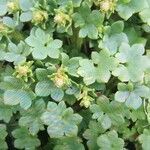Plants solitary or in tufts, not stoloniferous, weakly rhizom-atous, with small caudex. Leaves basal and cauline, (basal usually ephemeral, gradually dying through growing season, cauline conspicuous, reduced distally); petiole flattened, (5-)10-60(-90) mm; blade round to reniform, 3-7(-9)-lobed usually less than halfway to midvein (distal unlobed), (3-)5-18(-20) mm, slightly fleshy, margins entire, eciliate or sometimes sparsely glandular-ciliate, apex rounded, sometimes acute, surfaces glabrous or sparsely stipitate-glandular. Inflorescences 2(-5)-flowered paniculate or racemelike thyrses, sometimes solitary flowers, (flowers nodding in bud), some or all flowers but terminal one on each branch often replaced by bulbils, 3-30 cm, stipitate-glandular; bracts (proximal ephemeral), petiolate or sessile. Flowers: sepals erect, (sometimes reddish), oblong, margins glandular-ciliate, surfaces short-stipitate-glandular; petals white, not spotted, obovate to spatulate, 5-12 mm, longer than sepals; ovary superior. 2n = 24, 36, 48, 52, 56, 60, 70, 72.
Rhizomatous; stems solitary or few, 8–20 cm; lower lvs long-petioled, the blade reniform in outline, 10–25 mm wide, 3–7-lobed; upper lvs progressively smaller, shorter-petioled, and fewer-lobed, the uppermost ovate, entire, some with small axillary bulblets; fl solitary, terminal, white; pet 6–10 mm; 2n=36–72. Circumboreal, s. to the Gaspé Penins. of Que., Mt. Washington (N.H.), n. Minn., and Colo. July.

